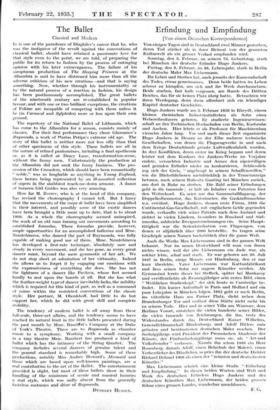The Ballet
Classical and Modern IT is one of the paradoxes of Diaghilev's career that -he, who was the instigator of the revolt against the conventions of classical ballet, should have retained a passionate love for that style even to the point, we are told, of preparing the public for its return to fashion by the process of outraging opinion with his later extravagances. The failure of his sumptuous production of The Sleeping Princess at the Alhambra is said to have distressed him more than all the adverse criticism of his new creations—and that is saying something. Now, whether through his instrumentality or by the natural process of a reaction in fashion, his design has been posthumously accomplished. The great ballets of the nineteenth century are re-established in popular favour, and with one or two brilliant exceptions, the creations of Fokine are incapable of competing with them unless it be (in Carnaval and Sylphides) more or less upon their own ground.
The repertory of the National Ballet of Lithuania, which has come ta the Alhambra for a season, consists mainly of classics. For their first performance they chose Glazounov's Raymonda, a work of Marius Petipa's extreme old age. The story of this ballet is neither more nor less silly than that of other specimens of this style. These ballets are all in the nature of refined pantomimes, including a final apotheosis or, as it is called at Drury Lane, transformation-scene, without the funny men. Unfortunately the production at the Alhambra did not omit the funny business. The pro- cession of the Crusaders, which should have been romantically "noble," was as laughable as anything in Young England, these heroes being represented by an ill-assorted collection of supers in the shabbiest reach-me-down armour. A dance of Saracen Girl Guides was also very amusing.
How far M. Zverev, who is at the head of this company, has revised the choreography I cannot tell. But I fancy that the movements of the corps de ballet have been simplified in their interest, and possibly some of the exotic dances have been brought a little more up to date, that is to about 1910. As a whole the choreography seemed uninspired, the work of an old man turning out movements according to established formulas. These formulas provide, however, ample opportunities for an accomplished ballerina and Mme. Nentt-chinova, who danced the part of Raymonda, was fully capable of making good use of them. Mme. Nemtchinova has developed a first-rate technique, tabsolutely sure and steady in every movement, and she has gone, as every great dancer must, beyond the mere gymnastic of her art. We do not stop short at admiration of her virtuosity. Indeed she allows us to forget it by engaging our emotions with the expressiveness of everything she does. She has not the lightness of a dancer like Pavlova, whose feet seemed hardly to rest upon the boards at all. But she has -what the feather-weight type of dancer inevitably lacks, the nobility which is required for this kind of part, as well as a command of mime within the restricted conventions of the classic style. Her partner, M. Oboukhoff, had little to do but support her, which he did with great skill and complete stolidity.
The tendency of modern ballet is all away from these full-scale, three-act affairs, and the tendency seems to have reached its natural limit in the little ballets presented during the past month by Mme. Rambtrfs Company at the Duke -of York's Theatre. These are to Raymonda as chamber music to a symphony. Working with a small company in a tiny theatre Mine. Rambert has produced a kind of ballet which has the intimacy of the String Quartet. The coinpany includes several dancers of genuine talent and the general standard is remarkably high. Some of these productions, notably Miss Andree Howard's Mermaid and those which are baled upon well-known Paintings, are a real contribution to the art of the Ballet. The entertainment provided is slight, but most of these ballets 'now in their handling of the minimum of scenic and musical luxuries a real style, which was sadly absent from the generally tasteless costurries and decor of Raymonda.
DYNELEY HUSSEY.


















































 Previous page
Previous page